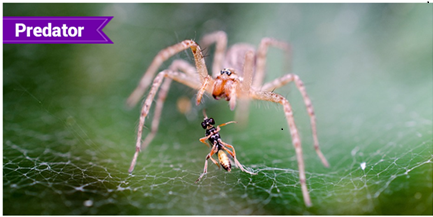Sun is the ultimate source of energy for all life on earth. Plants use this energy to make food. This energy is transferred when the plants get consumed by other organisms, and eventually, this energy makes its way up the food chain.
Table of Contents
Introduction
Predation is the interaction between prey and a predator, where the energy flows from one organism to the other. The predator is the organism that feeds on other organisms called prey.
Read on to explore what are predators and their types in detail.

What are Predators?
Predators are organisms that hunt and kill other organisms for food. The organisms that are consumed by the predators are known as the prey. Predators can be carnivores and omnivores. Lions, tigers, sharks, and snakes, all are predators.
Predators can also fall prey to other large animals depending on where they fall in the food chain. E.g. a snake is a predator to a mouse, but prey to a hawk.
Also Read: Energy Flow in the Ecosystem
Types of Predators
Predators can fall under the following categories:
Carnivores
Carnivorous predators kill and eat their prey. They include large animals such as the lion and tiger. Each carnivore has its own mode of feeding, from sea otters feeding on sea stars to blue whales feeding on zooplankton and small marine animals.
Herbivores
These include animals such as cows, buffaloes, goats, sheep, and deer, that consume plants and plant products.
Parasites
These predators live in the body of the host and derive nutrients from its body for survival and reproduction. In this, the host suffers a loss of energy but is not always killed.
Also read: Food Web
Predator Adaptations
Predators adapt in the following ways in order to attack and catch their prey:
- The predators use camouflage that helps them to hide from their prey so that they can make a sudden attack. This also prevents them from any dangerous defence mechanism a predator might have.
- Their mechanical adaptations such as sharp teeth, claws, thick skin and faster speed and superior strength help them to take over the prey.
- The chemical adaptations include venom, toxins and poison to kill the prey. They have also evolved chemical adaptations that protect them from the chemical defences of the prey, e.g. monarch butterflies feed on the milkweed plant that contains poison. They are evolved such that they are not affected by it.
Predator Examples
Following are some of the examples of predators:
Large Predators
Large predators have special adaptations to kill their prey. Polar bears, killer whales and great white sharks are some of the large predators found on earth.
The polar bear largely feeds on seals. The killer whales eat seals, sea lions, fish, etc. The great white sharks are the most dangerous ocean predator and feed on almost every organism.
Small Predators
Small predators do not cause mass destruction. E.g. sea stars feed largely on various types of shellfish. The ladybug is the smallest predator that feeds on aphids.
Other predators include lions, tigers, bears, wolves, leopards, dogs, snakes, crocodiles, etc.
Also Read: Carnivores And Herbivores
To know more about predators, their types and examples, keep visiting BYJU’S website.

Comments